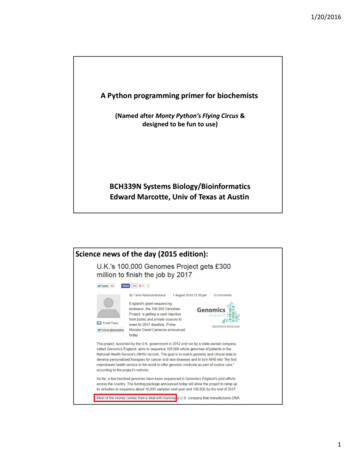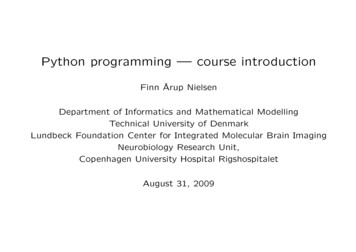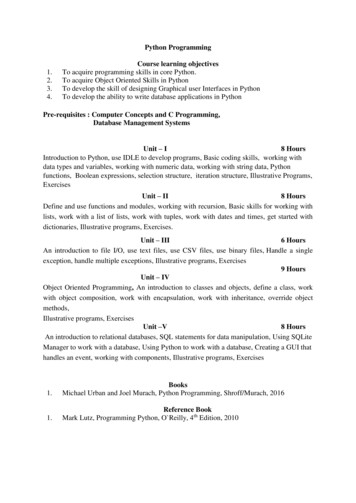
Transcription
1/20/2016A Python programming primer for biochemists(Named after Monty Python’s Flying Circus &designed to be fun to use)BCH339N Systems Biology/BioinformaticsEdward Marcotte, Univ of Texas at AustinScience news of the day (2015 edition):1
1/20/2016Science news of the day (2015 edition):Science news of the day (2016 update):2
1/20/2016In bioinformatics, you often want to do completely new analyses.Having the ability to program a computer opens up all sorts ofresearch opportunities. Plus, it’s fun.Most bioinformatics researchers use a scripting language, such asPython, Perl, or Ruby.These languages are not the fastest, not the slowest, nor best, norworst languages, but they’re easy to learn and write, and formany reasons, are well-suited to bioinformatics.We’ll spend the next 2 lectures giving an introduction to Python.This will give you a sense for the language and help us introducethe basics of algorithmsPython documentation: http://www.python.org/doc/& tips: http://www.tutorialspoint.com/pythonGood introductory Python books:Learning Python, Mark Lutz & David Ascher, O’Reilly MediaBioinformatics Programming Using Python: PracticalProgramming for Biological Data, Mitchell L. Model, O'ReillyMediaGood intro videos on Python:CodeAcademy: http://www.codecademy.com/tracks/python& the Kahn er-scienceA bit more advanced:Programming Python, 4th ed.Mark Lutz, O’Reilly Media3
1/20/2016By now, you should have installed Python on your computer,following the instructions in Rosalind Homework problem #1.Launch IDLE:You can test out commands hereto make sure they work Type in your program, save the file, andrun it . but to actually write your programs,open a new window.This window will serve as a command lineinterface & display your program output.This window will serve as a text editor forprogramming.Let’s start with some simple programs in Python:A very simple example is:print("Hello, future bioinformatician!")# print out the greetingLet’s call it hello.pySave & run the program. The output looks like this:Hello, future bioinformatician!4
1/20/2016A slightly more sophisticated version:name raw input("What is your name? ") # asks a question and saves the answer# in the variable "name"print("Hello, future bioinformatician " name "!")# print out the greetingWhen you run it this time, the output looks like:What is your name?If you type in your name, followed by the enter key, the program willprint:Hello, future bioinformatician Alice!GENERAL CONCEPTSNames, numbers, words, etc. are stored as variables.Variables in Python can be named essentially anything exceptwords Python uses as command.For example:BobsSocialSecurityNumber 456249685mole 6.022e-23password "7 infinite fields of blue"Note that strings of letters and/or numbersare in quotes, unlike numerical values.5
1/20/2016LISTSGroups of variables can be stored as lists.A list is a numbered series of values,like a vector, an array, or a matrix.Lists are variables, so you can name them just as you would nameany other variable.Individual elements of the list can be referred to using [] notation:The list nucleotides might contain the elementsnucleotides[0] "A"nucleotides[1] "C"nucleotides[2] "G"nucleotides[3] "T"(Notice the numbering starts from zero. This is standard in Python.)DICTIONARIESA VERY useful variation on lists is called a dictionary or dict(sometimes also called a hash).Groups of values indexed not with numbers (although they couldbe) but with other values.Individual hash elements are accessed like array elements:For example, we could store the genetic code in a hash namedcodons, which might contain 64 entries, one for each codon, e.g.codons["ATG"] "Methionine"codons["TAG"] "Stop codon"etc 6
1/20/2016Now, for some control over what happens in programs.There are two very important ways to control the logical flow ofyour programs:if statementsandfor loopsThere are some other ways too, but this will get you going for now.if statementsif dnaTriplet "ATG":# Start translating here. We’re not going to write this part# since we’re really just learning about IF statementselse:# Read another codonPython cares about the white space (tabs & spaces) you use!This is how it knows where the conditional actions that followbegin and end. These conditional steps must always beindented by the same number of spaces (e.g., 4).I recommend using a tab (rather than spaces) so you’re alwaysconsistent.7
1/20/2016Note: in the sense of performing acomparison, not as in setting a value. ! equalsis not equal tois less thanis greater thanis less than or equal tois greater than or equal toCan nest these using parentheses and Boolean operations, such asand, not, or or, e.g.:if dnaTriplet "TAA" or dnaTriplet "TAG" or dnaTriplet "TGA":print("Reached stop codon")for loopsOften, we’d like to perform the same command repeatedly or withslight variations.For example, to calculate the mean value of the number in an array,we might try:Take each value in the array in turn.Add each value to a running sum.Divide the total by the number of values.8
1/20/2016In Python, you could write this as:grades [93, 95, 87, 63, 75] # create a list of gradessum 0.0# variable to store the sumPython cares whether numbers are integers orfor grade in grades:sum sum gradefloatingoverpoint the(alsolistlongcalledintegersgradesand complex# iteratenumbers).# indentedcommandsexecutedTell Pythonyou wantarefloatingpoint by on# each cycleofyourthevariablesloop. accordinglydefining(e.g., X 1.0 versus X 1)mean sum / 5# now calculate the average gradeprint ("The average grade is "),mean # print the resultsIn general, Python will perform most mathematical operations, e.g.multiplicationdivisionexponentiationetc.(A * B)(A / B)(A ** B)There are lots of advanced mathematical capabilities you can explorelater on.9
1/20/2016READING FILESYou can use a for loop to read text files line by line:Stands for “read”count 0file open("mygenomefile", "r")for raw line in file:line raw line.rstrip("\r\n")words line.split(" ")# Declare a variable to count lines# Open a file for reading (r)# Loop through each line in the file\r #carriagereturnRemovenewline\n newline# split the line into a list of words# Print the appropriate word:print "The first word of line {0} of the file is {1}".format(count, words[0])count 1# shorthand for count count 1file.close()Increment counter by 1# Last, close the file.print "Read in {0} lines\n".format(count)Placeholders (e.g., {0}) in the printstatement indicate variables listedat the end of the line after theformat commandWRITING FILESSame as reading files, but use "w" for ‘write’:file open("test file", file.close()# close the file as you did beforeUnless you specify otherwise, you can find the new text file you created (test file) in thedefault Python directory on your computer.10
1/20/2016PUTTING IT ALL TOGETHERseq filename "Ecoli genome.txt"total length 0nucleotide {}seq file open(seq filename, "r")for raw line in seq file:line raw line.rstrip("\r\n")length len(line)for nuc in line:if nucleotide.has key(nuc):nucleotide[nuc] 1else:nucleotide[nuc] 1total length length# create an empty dictionary# Python function to calculate the length of a stringseq file.close()for n in nucleotide.keys():fraction 100.0 * nucleotide[n] / total lengthprint "The nucleotide {0} occurs {1} times, or {2} %".format(n, nucleotide[n], fraction)Let’s choose the input DNA sequence in the file to be the genome ofE. coli, available from the Entrez genomes web site or the class website.The format of the file is 77,000 lines of A’s, C’s, G’s and ACGCATTAGCACCACCATTACCACCACCATCACCATTACCACAGGTetc Running the program produces the output:The nucleotide A occurs 1142136 times, or 24.6191332553 %The nucleotide C occurs 1179433 times, or 25.423082884 %The nucleotide T occurs 1140877 times, or 24.5919950785 %The nucleotide G occurs 1176775 times, or 25.3657887822 %So, now we know that the four nucleotides are present in roughlyequal numbers in the E. coli genome.11
In bioinformatics, you often want to do completely new analyses. Having the ability to program a computer opens up all sorts of research opportunities. Plus, it's fun. . Bioinformatics Programming Using Python: Practical Programming for Biological Data, Mitchell L. Model, O'Reilly Media Good intro videos on Python:











